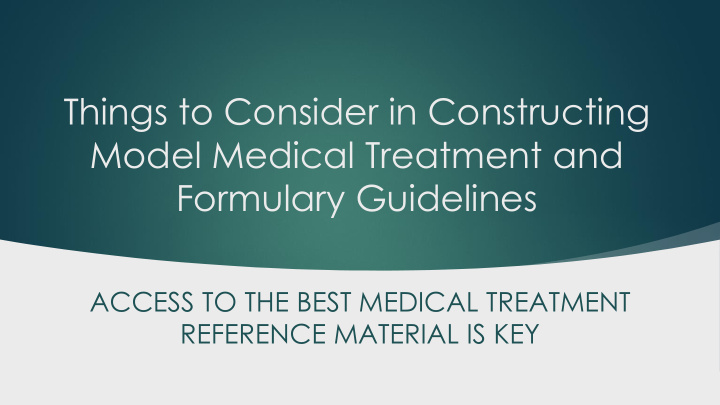



Things to Consider in Constructing Model Medical Treatment and Formulary Guidelines ACCESS TO THE BEST MEDICAL TREATMENT REFERENCE MATERIAL IS KEY
Can We Learn from the California Experience? ▪ A series of bills took effect in 2013-2016. Strategy: > Improve medical care delivery >Remove Waste, Friction, and Fraud ➢ > Use the savings to increase benefits for employees and reduce workers’ comp rates for employers. >Win – Win SB 863 (2012) , AB 1124 (2015), SB 1160 (2016), AB 1244 (2016)
How Was This Done? Improve healthcare quality and delivery. Use evidence-based guidelines for presumptive first-level treatment decisions. Establish protocol (hierarchy of decision making) for escalating to other treatment regimens based on individual circumstances. Reduce over-care, e.g., by calling for less invasive, evidence-based care first before surgery is decided upon. Eliminate litigation over issues that belong to the healthcare experts, not lawyers and judges.
The Foundation of Effective Reform? > Standardized reference material for first level, evidence-based treatment. > Drug formulary fully integrated with treatment parameters. > Most importantly: securing trust in the efficacy and integrity of guidelines for medical treatment, which fundamentally depends on addressing the us of drugs as part of treatment.
ACOEM Selection History: Rand (1) Evidence-based, Corp conducts a (2) Peer reviewed and nationally comprehensive recognized, study of existing (3) Address the full range of tests medical treatment and therapies commonly guidelines, utilized particularly for injuries applying the of spine, arm, and leg, following criteria (4) Reviewed or updated at least to rate their every three years, acceptability — (5) Developed by a Are they/Do multidisciplinary clinical team, they: (6) Cost less than $500 per individual user to subscribe
ACOEM stands out overwhelmingly as the best choice, particularly with its adherence to the principle of Rand evidence-based validation. Study ACOEM subsequently Evaluation: addresses recommendations of Rand Study for continuous improvement. ACOEM Guidelines, with integrated formulary, become the legal standard in California.
Why use the ACOEM Guidelines? They: Provide the clinician with an analytical framework for the evaluation and treatment of injured workers in the workers’ compensation system. Serve as the primary source of guidance for treating physicians and physician reviewers in workers 'compensation. As the presumed correct first-level standard for appropriate patient care, they enable streamlined approval of treatment requests. Help to protect workers from over, under, or otherwise inappropriate treatment. Include a comprehensive drug formulary as a fully integrated component of treatment.
How California selected a formulary: RAND study evaluation of 5 existing formularies. Data from Washington state Department of Labor and Industries. REED Group ACOEM. Work Loss data from Institute ODG. Ohio Bureau of Workers’ Compensation Department of Health Services (Medi-Cal)
Formulary Requirements: Established by evidence-based criteria as rigorous as thosecriteria underpinning the medical treatment utilization schedule (MTUS) Facilitate the provision of appropriate medical care to the injured worker by providing a list of the most effective medications, which not only benefits the patient but also minimizes unnecessary disputes and associated medical costs. Fully integrated with MTUS so that drug prescription, too often a separate consideration, is fully a part of the overall medical treatment plan for the patient.
Basis for selected Formulary Relies on evidenced-based criteria in determining drug list. Fully integrated with the MTUS. Transparency in the decisionmaking process to establish and keep current the list of approved drugs. Subjected to a procedure that ensures regular, state-of- the-art updates to the formulary. Easily understood and used by treating physicians. Focuses on drugs that are most effective in treating injured workers.
Challenges Confronting Any Attempt to Standardize Medical Treatment ➢ Resistance to change. ➢ Need to ensure maximum breadth of user base, i.e., all levels of healthcare professionals, claims adjusters, etc.
Recommend
More recommend